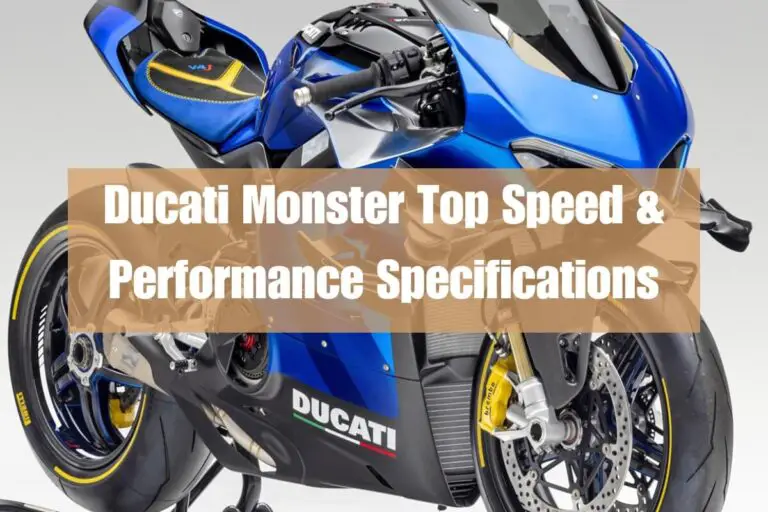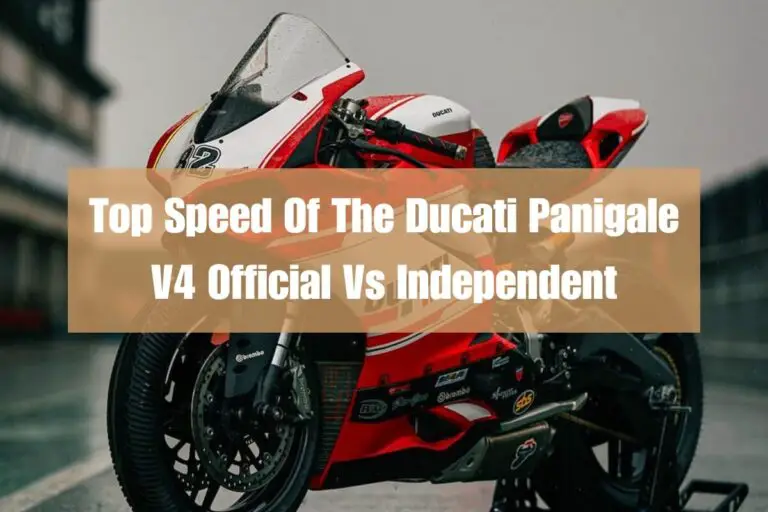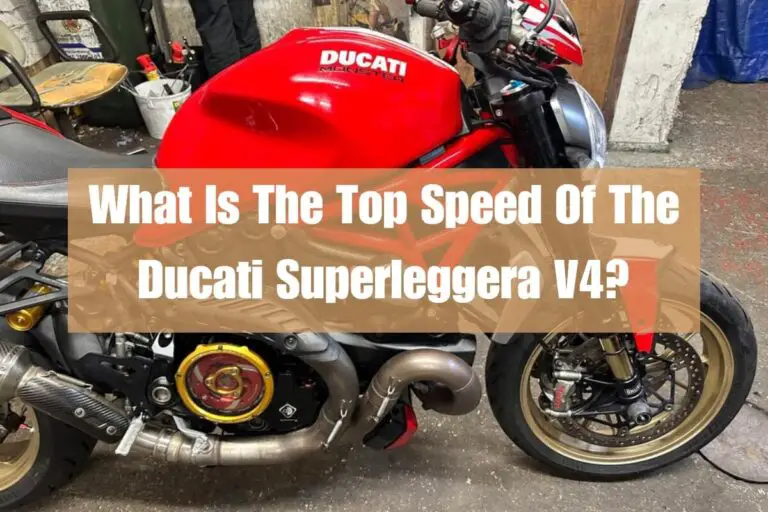Ducati Top Speed & Acceleration: Top Models Speed Tested!

Ducati motorcycles are revered for their exotic Italian styling, throaty exhaust notes, and blistering acceleration. But Ducati models are also capable of reaching incredibly high top speeds exceeding 180 mph. Their optimized designs allow riders to chase horizon-blurring velocity.
Key Ducati models like the Panigale V4, Superleggera V4, Monster, and Panigale V2 all deliver thrilling speed, with some capable of hitting 60 mph in under 3 seconds. Let’s examine the top speed and performance potential of these amazing Italian superbikes.
Ducati Panigale V4 Top Speed and Acceleration

The range-topping Ducati Panigale V4 superbike is powered by a 1,103cc V4 engine producing 214 hp, allowing a top speed of 186 mph. But some have reached 194+ mph with ECU tuning.
Acceleration
- 0-60 mph in 2.6 seconds
- 0-124 mph in 7.6 seconds
Key Specs
- Displacement: 1,103 cc
- Power: 214 hp @13,000 rpm
- Torque: 92 lb-ft @ 10,000 rpm
Its stability at speed comes from aerodynamic bodywork, a rigid chassis, finely tuned suspension, and grippy tires. Electronics like traction control and wheelie control help put the power down.
Ducati Superleggera V4 Top Speed

The exotic Superleggera V4 takes lightweight construction and power to another level. Its 998cc desmosedici V4 engine pumps out 234 hp, for a top speed estimated over 200 mph with its limiter deactivated.
Acceleration
- 0-60 mph in 2.6 seconds
- 0-100 mph in 5.67 seconds
Key Specs
- Dry Weight: 335.5 lbs
- Power: 234 hp @ 15,500 rpm
- Torque: 87.7 lb-ft @ 11,750 rpm
Extensive use of carbon fiber including the frame, wheels, and bodywork minimize weight to an incredible 335.5 pounds dry. The Empire State Building could be demolished over 40 times with the materials used on one Superleggera V4. This featherweight rocket ship has plenty of headroom to exceed 200 mph given the power and aerodynamics.
Ducati Monster Top Speed
The naked Ducati Monster muscle bike is powered by a nimble 937cc Testastretta V-twin engine producing 111 hp, giving it a top speed around 135 mph – very fast for a naked bike.
Acceleration
- 0-60 mph in 3.3 seconds
- Quarter mile in 12.3 seconds at 120 mph
Key Specs
- Engine: 937cc liquid-cooled L-twin
- Power: 111 hp @ 9,250 rpm
- Torque: 69.5 lb-ft @ 6,500 rpm
The minimal bodywork slicing through the wind helps contribute to the Ducati Monster’s top end stability. Components like adjustable suspension, beefy 50mm forks, grippy Pirelli Diablo Rosso III tires, and Brembo brakes also aid performance.
While the Monster gives up some outright top speed to faired Ducatis, its nimble chassis still runs down most adversaries.
Ducati Panigale V2 Top Speed
The smaller displacement 955cc Panigale V2 superbike boasts an incredible top speed of 174 mph – a blistering velocity for a middleweight sportbike. Its 155 eager Italian horses gallop across the tach to a stratospheric peak at 10,750 rpm.
Acceleration
- 0-60 in 3.09 seconds
- Quarter mile in 10.4 seconds
Key Specs
- Engine: 955cc liquid-cooled Superquadro V-twin
- Bore x stroke: 100mm x 60.8mm
- Compression ratio: 12.5:1
- Power: 155 hp @ 10,750 rpm
The Ducati Panigale V2 hits 60 mph quicker than a Lamborghini Huracan thanks to its high-strung twin. Given enough road, its top speed rivals Japanese literbikes from 15 years ago. The aerodynamics and compact ergonomics help shrink the bike’s frontal area to penetrate the air.
Factors That Determine Top Speed
Ducati superbikes achieve such fast top speeds thanks to:
- Powerful Engine Performance – High horsepower engines with abundant torque and stratospheric redlines
- Lightweight Components – Carbon fiber, forged aluminum parts enable quick acceleration
- Aerodynamic Bodywork – Fairings, windscreens, and wings reduce drag
- Suspension Setup – Adjustable components dial in stability and handling
- Gear Ratios – Close-ratio 6-speed transmissions keep engines in the powerband
- Electronics – Sophisticated rider aids like traction control get power to the ground
So while horsepower gets the headlines, creating a motorcycle capable of exceeding 175 mph requires optimizing every design and engineering choice.
Comparison to Competition
Ducati bikes match or beat the top speed of most production superbikes:
- Kawasaki Ninja ZX-10R: 186 mph
- BMW S1000RR: 188 mph (with optional M package)
- Aprilia RSV4 1100 Factory: 199 mph
- Honda CBR1000RR-R: 215 mph (electronically limited)
The Kawasaki Ninja H2R track-only hyperbike exceeds 310 mph but is not street legal. Meanwhile, the Suzuki Hayabusa and Kawasaki Ninja H2 narrowly surpass Ducati with forced induction power at over 200 hp.
But for exotic Italian superbikes, Ducati models set the bar for thrilling yet road-friendly performance.
Modifications for More Speed
Owners chasing ultimate velocity can consider these proven mods:
- Aftermarket Exhaust System – Reduces weight while adding 10+ hp
- Air Intake/Filter Kit – Improves engine breathing
- ECU Reprogramming – Custom tuning optimizes fueling
- Raise or Remove Rev Limiter – Allows higher rpm for more power
- Lower Rear Sprocket Count – Increases top speed via higher gear ratios
With some expert tuning focused on engine airflow and ignition timing, gaining 15-20 horsepower is possible. But reliability may suffer if components are pushed too far beyond factory specs.
Pros and Cons of Ducati Superbikes
Ducati sportbikes offer an unforgettable experience but also have downsides:
Pros:
- Exhilarating power delivery and acceleration
- Gorgeous Italian styling turns heads
- Race-bred pedigree and exotic components
- Advanced electronics and adjustable parts
Cons:
- Expensive purchase and maintenance costs
- Uncomfortable ergonomics for casual riding
- Frequent major service intervals
- Low fuel range and erratic low speed fueling
While these exquisite machines demand some compromises in practicality, few experiences match unleashing Ducati’s thunder down an open straightaway.
Top Alternatives to Consider
Riders seeking comparable exotic Italian superbikes may want to consider Aprilia RSV4 and MV Agusta F4 models. These offer similar performance in a more affordable package but don’t quite match Ducati’s allure and pedigree.
Pricing and Availability
Ducati superbikes range from $20,000 to $80,000 USD for ultra-limited production variants like the Superleggera V4. High demand keeps values strong in the used motorcycle market as well. Shoppers can browse new and used inventory at their local dealers.
Here are some Ducati models and their starting prices:
- Hypermotard 698 Mono: $12,995
- Hypermotard 698 Mono RVE: $14,495
- Hypermotard 950: $15,295
- Hypermotard 950 RVE: $16,095
- Hypermotard 950 SP: $18,995
- 2023 Ducati SuperSport 950: $15,195
- 2024 Ducati DesertX Rally: $22,995
- 2022 Ducati Panigale V2: $17,395
Major Ducati Problems and Solutions
1. Overheating Issues
- Causes: Low coolant, faulty water pump/fans, clogged radiator
- Fixes: Top up coolant, replace water pump/fans, clean radiator passages
2. Electrical Gremlins
- Causes: Faulty battery, wiring issues, flakey connections
- Fixes: Inspect battery cables; check for loose/damaged wires; solder/replace bad connections
3. Clutch Problems
- Causes: Worn clutch plates, weak clutch springs, damaged basket
- Fixes: Replace clutch plates/springs; inspect basket and replace if damaged
4. Difficult Starts
- Causes: Weak battery, clogged fuel filter, clutch switch issue
- Fixes: Test & replace battery; inspect & replace fuel filter; adjust clutch switch
5. Excessive Oil Consumption
- Causes: Worn piston rings, leaking gaskets, defective PCV valve
- Fixes: Replace piston rings; reseal gaskets; test/replace PCV valve
What Ducati Owners Are Saying?
Positive:
“After the break-in period, my Monster pulls hard through every gear – pure Italian magic!”.
Negative:
“The dry clutch on my Panigale V2 is super high maintenance – I’ve had to replace the plates twice already”.
Frequently Asked Questions
How often should valve clearances be checked?
Every 7,500 miles after the initial 15,000 mile check. The desmo V-twin engines use precise clearances.
Do Ducatis overheat in stop and go traffic?
Yes, many owners install oil coolers and radiator fans to help cope with heat buildup. Consider an Evotech radiator guard as well to deflect hot air during low speed riding.
What type of gas should I use in my Ducati?
Premium 93+ octane fuel is recommended for optimal performance and detonation resistance.
How long do Ducati engines last?
With proper maintenance, the L-twin engines can log 60,000+ miles. The V4 models remain unproven for longevity but share technology with Ducati’s racebikes.
Final Opinion
With a racing heritage few can match, Ducati motorcycles continue pushing the limits of speed and technology. Models like the Panigale V4, Streetfighter V4, Superleggera, and Monster marry exotic Italian styling with blistering acceleration over 180 mph. These advanced superbikes give owners a taste of MotoGP performance for the street. While the pursuit of maximum velocity certainly carries risks, few machines deliver such a raw, unfiltered sensory experience. For riders desiring the breathtaking thrill of extreme speed, Ducati stands in a class of its own.
